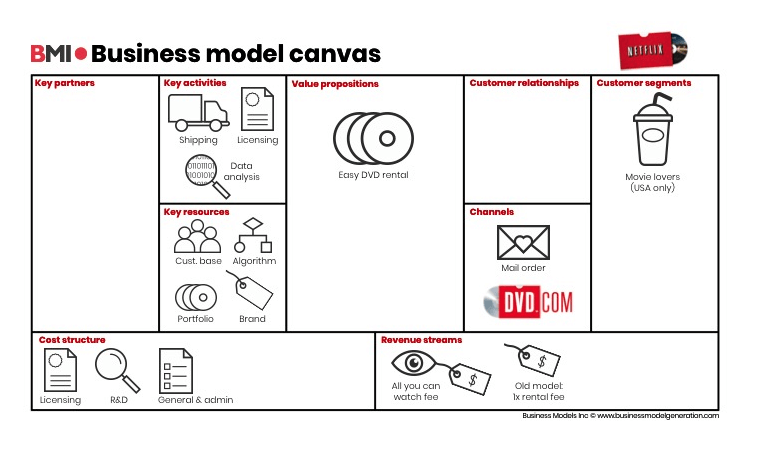
How Netflix Moved Operations to the Cloud and Saw Revenue Boom: A Digital Transformation Case Study
Remember the time you had to request mail-order DVDs to catch the latest flicks while munching popcorn on your couch?
Me neither.
It’s strange to think that about a decade ago, streaming giant Netflix had a business model built around direct mail.
Request a movie, put a few in your queue for next time, and let the anticipation build as you wait for your first DVD to arrive on your doorstep.
Now, our instant gratification bells ring daily as we pour through episode after episode of new material. And, we can barely remember the (dark) time where we waited days for entertainment instead of having it literally at our fingertips.
The shift from mail-in orders to a cloud streaming service improved customer satisfaction and made Netflix billions.
The company’s move to the cloud came with a hike in customer loyalty and a brand that competitors still fight tooth and nail to beat in the market.
Netflix serves as the ultimate digital transformation case study.
They transformed their entire business model and charted unprecedented waters. Here’s how to use their model as inspiration for your contact center’s digital transformation.
How to move your operations to the cloud, Netflix style: A digital transformation case study.
21 years after they started renting DVDs, Netflix now sits at a valuation of almost $145 Billion.
They came to market as a disruptor of traditional video stores like Blockbuster and Family Video.
Netflix founders Reed Hastings and Marc Randolph wanted to bring customer-centricity to the video rental market. At the time, renting videos was inconvenient and costly, with customers often plagued by expensive late fees.
They created an entirely new way to watch movies and consume content. And as time went on and subscribers grew, they continued to shift to keep pace with new consumer demands.
In 2007, they took their first step into the world of streaming video. They offered customers a streaming subscription in addition to the more traditional DVD rental service, giving customers the option to chart their own path.
Since then, they’ve seen exponential growth in subscribers and revenue. Let’s take a look at their trends over time. We’ll skip over the first few years of the company’s infancy and jump to the year the company went public.
Here’s how Netflix has grown since 2002.

That incredible growth trajectory, and willingness to change, made Netflix stock skyrocket by 6,230% in a 10-year period.
And, they did it all without crazy price hikes, keeping customers top-of-mind.
While Netflix has adjusted prices over the years, they strike a balance by adding more value and services for the dollar. In 2019, the Basic plan increased by $1 a month (adding up to $12 annually). While the Standard and Premier plans rose by $2 per month, (adding up to $24 annually, for each plan).
Meanwhile, the company is putting some $15 billion towards creating new content binge-watchers will love.
After this price change, Netflix saw a slight blip in subscriber growth, with growth in Q2 coming in low. But, analysts don’t think for a second it’s the beginning of a downward trend. In fact, a similar event happened back in 2010 when Netflix moved to a pricing model that broke out streaming and video rentals. And they clearly rebounded.
When you put the numbers into perspective, you see this is the first dip in subscriber growth in nearly a decade. That’s pretty remarkable. And, revenue still increased for the quarter. It’s clear the value of the digital innovator’s services still outweighs the cost for most.
Plus, if you can post positive revenue numbers for over a decade and become a multi-billion-dollar company in about 20 years, you’re doing alright.
Here’s what Netflix did to reach these lofty heights. And, how you study the same tactics to lead your contact center through a successful digital transformation.
Stay true to your vision.
Netflix started out with the idea to make it easier and less expensive for people to watch movies.

But they didn’t want to stay in the DVD game forever. They had the foresight to predict that consumer behaviors would continue to shift. And, they wanted to stay ahead of the competition.
Only, they didn’t sacrifice their vision when it came time for company-wide changes. Instead, they realigned their business strategies to fit their vision, even as consumers and trends shifted.
What you can do:
As you make digital shifts in your contact center and your company, keep your vision constant. While tons of other factors may orbit around you, your vision keeps you grounded.
Use your company vision to guide your decision-making. And, use data and trends to predict how your customer behavior will shift.
As you shift to keep pace with your customers’ needs, align your operations to your customer behaviors to realize your vision.
Reinvent the wheel if the old one doesn’t solve customer problems.
Netflix soared from seed idea to a $145-billion-dollar valuation in only 21 years. (Wow, they did that in less time than it took big tech vendors to break CSAT scores.)
And they didn’t get there by spinning up a new-and-improved version of Blockbuster.
Ted Sarandos, Head of Content at Netflix said when he came on board at the early stages of the company founder Reed Hastings used his vision to scale and innovate at Netflix.
“We never spent one minute trying to save the DVD business,” said Sarandos.
The company leaders didn’t stick to traditional best practices because they no longer worked for modern customers.
Instead of piggybacking off what other companies did, Netflix solved problems differently. And, they solved them better. The proof is in a bankrupt Blockbuster and dwindling Family Video stores.
Want to know what you’re missing when you only look at digital transformation best practices? Pop over to our article on the topic.
What you can do:
Tailor your path and contact center strategies to your specific business needs. Focus on listening and understanding your customers, with the help of better data and customer surveys.
Find out what’s causing your customers’ pain. See what common questions your customers have. Work with your sales team to find out why customers are fleeing competitors. Discover why they choose your products and services in the first place. Then, work with your contact center and company leaders to develop the methods to solve these pains.
Don’t get caught up in what your competition is doing. What they’re doing might work, but your actionable data and customer information can guide you to a way that works better.
If you’re going to be consumed by one thought, let it be this one: how might we better serve our customers?
Don’t force your customers down a single path.
In the early phases of Netflix, internet speeds weren’t built for streaming movies. People who tried to download and view movies online were only frustrated by the lengthy, often interrupted experience of watching a film online.
Netflix didn’t want to enter the streaming market until the right infrastructure was available to support a platform with high-quality and high-speed content. They didn’t want to taint their brand from day one, linking the Netflix name to all the baggage that came with poor streaming experiences.
At the same time, they were watching postage prices. The price of postage kept rising, and internet speeds were on the ups. By watching how the market and internet infrastructure changed, they identified the right moment to launch their first streaming service.
They tested their streaming service with lower-quality video, first. They wanted to gauge interest and customer experience without canceling their bread-and-butter DVD service.
Those who wanted access to the crisp DVD picture could still order movies to their doorstep. Others who wanted instant access could forgo the high-quality picture for convenience, instead.
What you can do:
Your contact center and customer experience will change. It has to. But as you make changes and shift your operations to the digital era, keep options open for your customers.
Just because chat and email are on the rise as popular customer service channels doesn’t mean every customer wants to use them. Use past data and communication history to learn more about your customers. Then, coach your agents to handle each interaction based on the customer’s preferences.
Bringing changes to your contact center has the potential to transform your customer experience for the better. But, without careful intention, it can also cause friction. Introduce changes to your customers slowly, and make sure your agents are always there to offer extra help through the process.
Use data and trends to personalize your customer experiences.
This one’s huge. It’s how Netflix keeps customers engaged with their platform, and how they coined the term binge-watching
As Netflix made changes in their operations, they watched their data like a hawk. They looked for trends on how people watched content, what kept them watching, and how personalization fueled content absorption. Then, they used an algorithm to serve up content tailored to their customers’ specific interests.
“Like a helpful video-store clerk, it recommended titles viewers might like based on others they’d seen.” – Twenty Years Ago, Netflix.com Launched. The Movie Business Has Never Been the Same, by Ashley Rodriguez for Quartz.
And, as their new cloud-based business let them scale globally, their data points multiplied.
Previously, Netflix could only mail DVDs to U.S. customers. Shipping DVDs overseas wouldn’t have been financially sustainable while keeping prices fair for all customers. Moving to an online business model allowed Netflix to target and reach new audiences without taking on the costs of shipping globally.
Doing this not only scaled their business, but it diversified their data and made their algorithm smarter. Enter, extreme personalization and binge-watching fever on a global scale.
What you can do:
Track and analyze data from your customer interactions. Create custom reports and dashboards to distill important findings from your data. Then, use the trends and patterns you find to personalize your customer service experiences.
From the way you send customer surveys to the tone your agents use, your interactions tell you what your customers want. Lean into your analytics for valuable insight into how to help your customers.
And, use the data to transform your contact center too. Customer data is a powerful tool to drive business change. If your metrics show customers aren’t happy, your company leaders want to know about it. And, they’ll want to fix it. There’s no better case for company transformation.
Netflix took risks to transform their business. But, there’s no bigger risk than stagnation. Staying the same doesn’t help you reach your contact center goals. Innovating and trying out your big ideas is what separates the leaders from the laggards.
Can your tech vendor survive in your digital transformation?
Learn how to choose vendors who make your transformation strategy possible.

